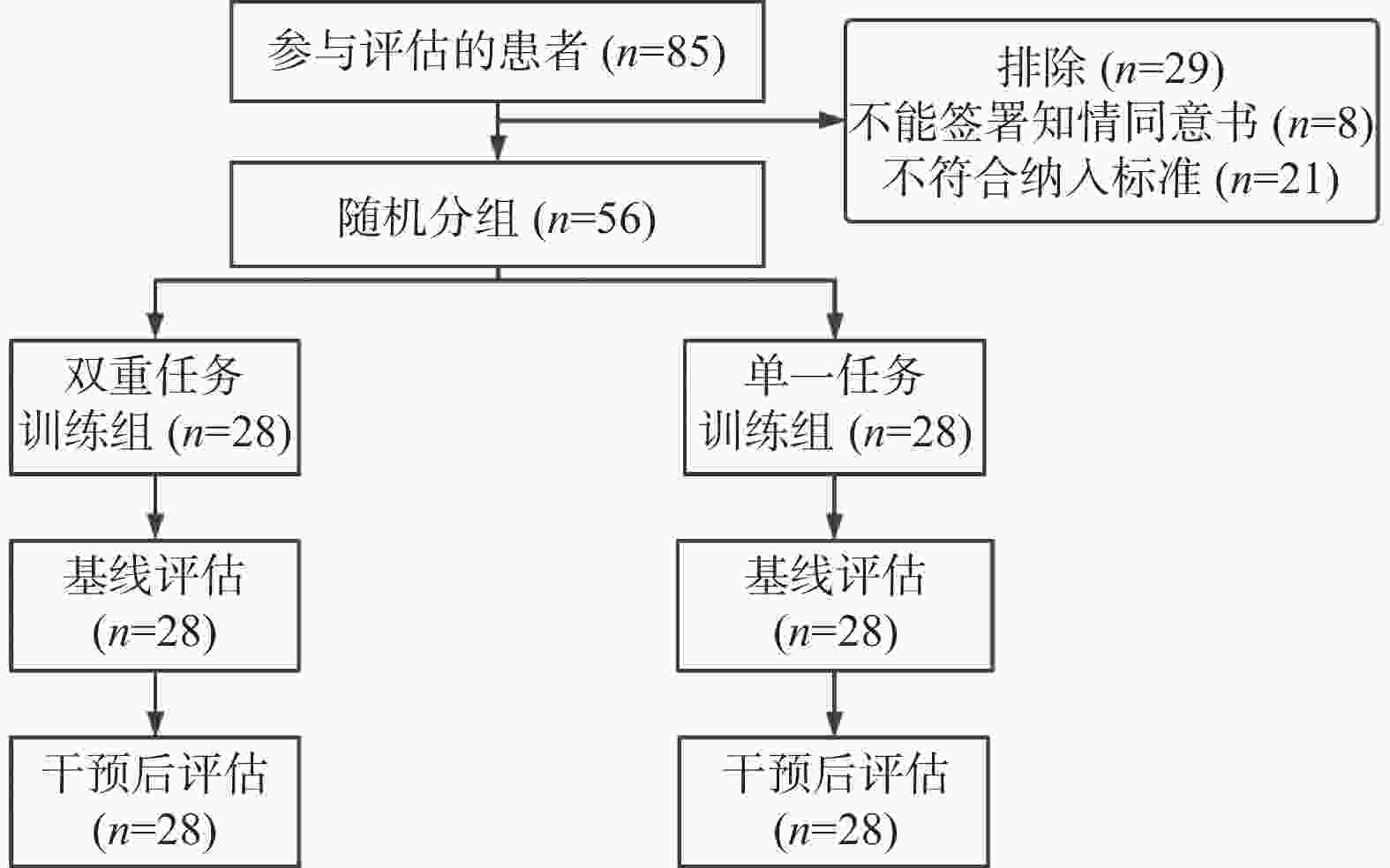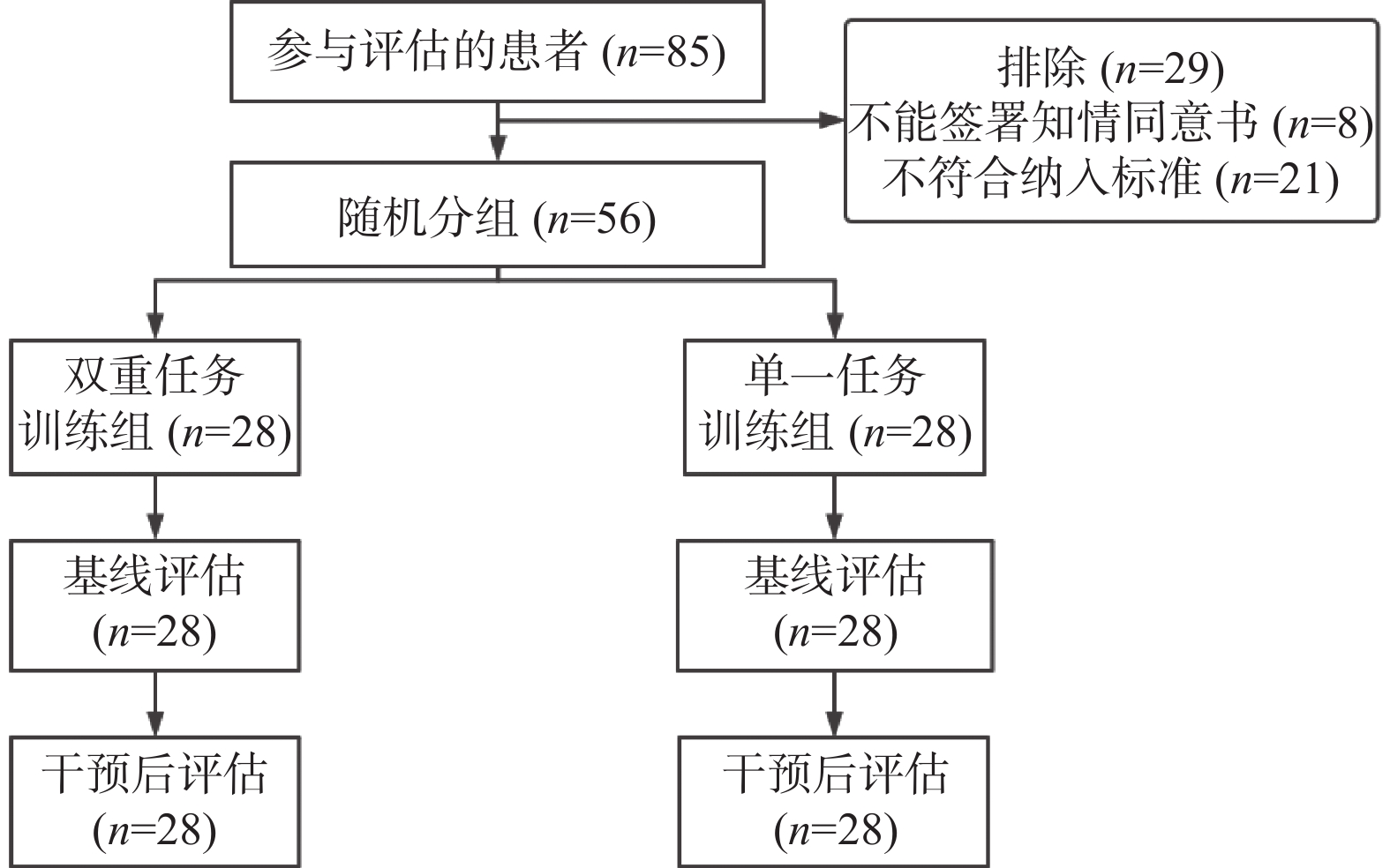Effect of Dual-task Training on Mobility Function in Patients with Parkinson’s Disease
-
摘要:
目的 检验双重任务训练对帕金森患者运动功能的影响。 方法 56名帕金森患者随机分为实验组和对照组。每组患者接受为期2周,每周5次,每次60 min的训练,并比较2组患者训练前后的运动和认知功能。 结果 尽管2组患者完成10 m步行和起立行走计时(TUG)测试的时间变化值无显著差异(P > 0.05),但仅有实验组在双重任务状态下改善显著( P < 0.05)。对于简易平衡评定系统测试和特定活动平衡信心量表,仅有实验组呈现出显著的时间效应。 结论 双重任务训练对帕金森患者步行速度和平衡功能具有改善趋势。未来的研究应该探索改善帕金森病患者运动功能的最佳训练方案,以及将获得的能力转移到其他新的双重任务场景的问题。 Abstract:Objective To examine the effect of dual-task (DT) training on mobility function in patients with Parkinson’s disease (PD). Methods 56 patients with PD were randomly divided into DT training group or single-task (ST) training group. Each group of patients received the 60 min/session training, 5 times/week, for over 2 weeks. The motor and cognitive functions of the two groups were compared before and after the training. Results Although there was no significant difference between the two groups in the change time taken to complete the 10 m walking and timed up and go (TUG) test under either DT or ST condition, only the experimental group improved significantly under DT condition (P < 0.05). For balance function (mini-balance evaluation system test, Mini-BESTest) and balance efficiency (activity-specific balance confidence scale, ABC), only DT training group showed the significant time effect. Conclusion Walking speed and balance function in patients with PD tend to be improved after DT training. Future research should be conducted to explore the optimized training protocol and improve DT motor function in patients with PD and the ability of transferring the acquired function to new DT scenarios. -
Key words:
- Parkinson’s disease /
- Dual task /
- Walking ability /
- Balance function /
- Randomized controlled trial
-
表 1 人口学特征[(
$ \bar x \pm s $ )/M(IQR)/n(%)]Table 1. Characteristics of participants [(
$ \bar x \pm s $ )/M(IQR)/n(%)]项目 实验组 (n = 28) 对照组 (n = 28) 统计量(t/χ2/U) P 基本人口统计数据 年龄 (岁) 62.7 ± 7.2 63.2 ± 8.6 0.035 0.428 女性 10 (35.7) 12 (42.8) 0.299 0.585 身体质量指数 (kg/m2) 23.8 ± 2.6 23.3 ± 3.7 0.476 0.608 帕金森疾病的特征 发病时间 (a) 6.6 ± 4.2 7.6 ± 5.0 −0.428 0.495 Hoehn-Yahr分期 2.5 (2,3) 2.5 (2,3) 14 0.510 运动状态 室内步行辅助 3 (10.7) 2 (7.1) 0.22 0.639 室外步行辅助 5 (17.9) 3 (10.7) 0.583 0.445 在过去12个月内至少有一次跌倒的受试者 11 (39.3) 6 (21.4) 2.112 0.146 *P < 0.05。 表 2 干预前后2组完成步行任务所需时间比较 [(
$ \bar x \pm s $ ),秒]Table 2. Comparison of the time taken to complete the walking task between the two groups before and after treatment [(
$ \bar x \pm s $ ),s ]项目 实验组 对照组 基线比较 2组治疗前后变化值比较 训练前 训练后 变化值 训练前 训练后 变化值 t P t P 10 m步行 单一任务 20.5 ± 15.1 18.6 ± 13.5 −1.9 ± 14.37* 14.5 ± 5.4 13.3 ± 5.4 −1.2 ± 5.4 1.937 0.102 −0.419 0.677 +命名任务 25.7 ± 3.2 20.9 ± 2.4 −4.8 ±19.51* 17.3 ± 3.8 15.9 ± 2.9 −1.4 ± 3.44 1.942 0.094 −1.566 0.123 +连续减3任务 26.3 ± 3.5 21.7 ± 2.5 −4.6 ± 21.46* 17.9 ± 4.2 15.8 ± 3.0 −2.1 ± 3.75 1.730 0.128 −1.151 0.255 TUG 单一任务 24.4 ± 2.7 23.2 ± 2.4 −1.2 ± 15.94 17.7 ± 3.3 16.0 ± 3.0 −1.7 ± 3.16 1.791 0.124 −0.574 0.568 +命名任务 34.0 ± 4.1 25.9 ± 2.6 −8.1 ± 3.59* 22.4 ± 5.0 19.8 ± 3.2 −2.6 ± 4.39 1.963 0.080 −1.662 0.102 +连续减3任务 33.8 ± 4.0 26.6 ± 2.8 −7.2 ± 3.56* 22.1 ± 4.9 19.5 ± 3.4 −2.6 ± 4.35 1.971 0.070 −1.130 0.264 *P < 0.05。 -
[1] He Y,Yang L,Zhou J,et al. Dual-task training effects on motor and cognitive functional abilities in individuals with stroke:A systematic review[J]. Clin Rehabil,2018,32(7):865-877. doi: 10.1177/0269215518758482 [2] Baek C Y,Chang W N,Park B Y,et al. Effects of dual-task gait treadmill training on gait ability, dual-task interference, and fall efficacy in people with stroke:A randomized controlled trial[J]. Phys Ther,2021,101(6):67. [3] Plummer P,Eskes G,Wallace S,et al. Cognitive-motor interference during functional mobility after stroke:State of the science and implications for future research[J]. Arch Phys Med Rehabil,2013,94(12):2565-2574. doi: 10.1016/j.apmr.2013.08.002 [4] Zirek E,Ersoz Huseyinsinoglu B,Tufekcioglu Z,et al. Which cognitive dual-task walking causes most interference on the timed up and go test in Parkinson’s disease:A controlled study[J]. Neurol Sci,2018,39(12):2151-2157. doi: 10.1007/s10072-018-3564-2 [5] Li Z,Wang T,Liu H,et al. Dual-task training on gait, motor symptoms, and balance in patients with Parkinson’s disease: A systematic review and meta-analysis[J]. Clin Rehabil,2020,34(11):1355-1367. doi: 10.1177/0269215520941142 [6] Fernandes A,Rocha N,Santos R,et al. Effects of dual-task training on balance and executive functions in Parkinson's disease:A pilot study[J]. Somatosens Mot Res,2015,32(2):122-127. doi: 10.3109/08990220.2014.1002605 [7] Strouwen C,Molenaar E A,Keus S H,et al. Test-retest reliability of dual-task outcome measures in people with Parkinson disease[J]. Phys Ther,2016,96(8):1276-1286. doi: 10.2522/ptj.20150244 [8] Penko A L,Barkley J E,Rosenfeldt A B,et al. Multimodal training reduces fall frequency as physical activity increases in individuals with Parkinson's disease[J]. J Phys Act Health,2019,16(12):1085-1091. doi: 10.1123/jpah.2018-0595 [9] De Freitas T B,Leite PHW B S,Doná F,et al. The effects of dual task gait and balance training in Parkinson’s disease: A systematic review[J]. Physiother Theory Pract,2020,36(10):1088-1096. doi: 10.1080/09593985.2018.1551455 [10] Yang Y,Cheng S,Lee Y,et al. Cognitive and motor dual task gait training exerted specific training effects on dual task gait performance in individuals with Parkinson’s disease:A randomized controlled pilot study[J]. PLOS ONE,2019,14(6):e218180. [11] San M V C,Moscardo L D,Lopez-Pascual J,et al. Effects of dual-task group training on gait, cognitive executive function, and quality of life in people with Parkinson disease: Results of randomized controlled DUALGAIT trial[J]. Arch Phys Med Rehabil,2020,101(11):1849-1856. doi: 10.1016/j.apmr.2020.07.008 [12] Wang X Q,Pi Y L,Chen B L,et al. Cognitive motor intervention for gait and balance in Parkinson’s disease:Systematic review and meta-analysis[J]. Clin Rehabil,2016,30(2):134-144. doi: 10.1177/0269215515578295 [13] Carter N D,Khan K M,Mckay H A,et al. Community-based exercise program reduces risk factors for falls in 65- to 75-year-old women with osteoporosis:Randomized controlled trial[J]. CMAJ,2002,167(9):997-1004. [14] 王云龙,陈长香,马素慧,等. 简易平衡评定系统测试平衡量表应用于脑卒中患者的因子分析[J]. 中国康复医学杂志,2015,30(5):496-500. doi: 10.3969/j.issn.1001-1242.2015.05.019 [15] Ishige S,Wakui S,Miyazawa Y,et al. Reliability and validity of the Activities-specific Balance Confidence scale-Japanese (ABC-J) in community-dwelling stroke survivors[J]. Phys Ther Res,2020,23(1):15-22. doi: 10.1298/ptr.E9982 [16] 杨谦,第五永长,王威,等. 蒙特利尔认知评估量表用于社区轻度认知障碍筛查的初步研究[J]. 中风与神经疾病杂志,2022,39(2):139-142. doi: 10.19845/j.cnki.zfysjjbzz.2021.0033 [17] Johansson H,Ekman U,Rennie L,et al. Dual-task effects during a motor-cognitive task in Parkinson’s disease:Patterns of prioritization and the influence of cognitive status[J]. Neurorehabil Neural Repair,2021,35(4):356-366. doi: 10.1177/1545968321999053 [18] Plummer P,Iyigün G. Effects of physical exercise interventions on dual–task gait speed following stroke:A systematic review and meta-analysis[J]. Archives of Physical Medicine and Rehabilitation,2018,99(12):2548-2560. doi: 10.1016/j.apmr.2018.04.009 [19] Plummer P,Eskes G. Measuring treatment effects on dual-task performance:A framework for research and clinical practice[J]. Front Hum Neurosci,2015,9(4):225. -






 下载:
下载:







